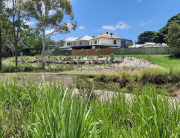Water supply and security is an issue that is never far from the top of Queenslander’s minds. From drought to deluge, how we manage, harvest and supply water is a hot topic, particularly as many areas of the state are still drought-declared, with water storage in dams still alarmingly low.
Many experts are predicting increased intensity and duration of future droughts, meaning that action must be taken to help secure the long-term water needs of users across the state, from farmers in our regions to families in our growing cities.
So, what options are available? Two approaches are currently making headlines and we would love to hear your thoughts on each.
One way forward is to revisit the Bradfield Scheme, which moves water from the north of Queensland to the dry areas in the west. A recent article in Brisbane Times explains that a new panel lead by economist Ross Garnaut will conduct a comprehensive government review of the scheme to decide whether it is worth the immense investment.
The LNP, has already committed $20 million to the scheme if they are elected and say that it will “drought-proof western Queensland and set up Queensland for the next 100 years”.
Another recent article from the ABC proposes that we need to think differently all together about how we source water. Australian Rivers Institute director Stuart Bunn argues that building more infrastructure is not the key to solving the issue in the long term, but instead we should be looking at how we harvest and reuse water. In particular, this includes how we could capture the excessive amount of stormwater runoff in a city like Brisbane.
A paper by the Water Services Association of Australia further outlines water security in Australia and the different water supply options. It argues that we need to move towards a more diversified portfolio of water supply options if we want to keep up with the water needs of our growing cities and regional centres and the impacts of climate change and drought. Download the paper here.
With the goal in mind to improve our water security, what would you, as an active member of the stormwater community recommend as a sustainable way forward for our water supply?








Leave A Comment
You must be logged in to post a comment.